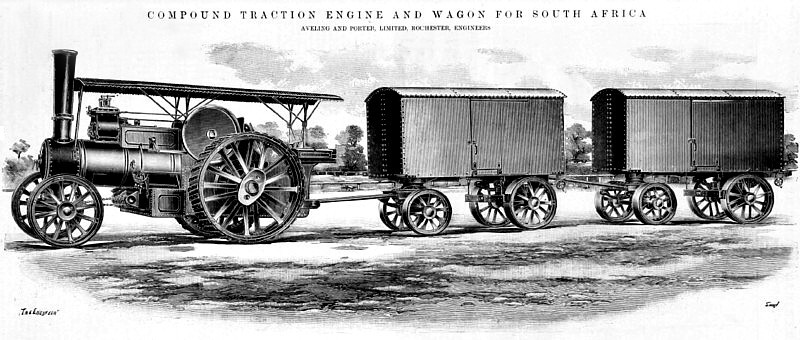|
Title: |
1900 Article-Aveling & Porter, Compound Steam Traction Engine & Wagons |
|
Source: |
The Engineer Magazine, 26 Jan 1900, pg. 99 |
|
Insert Date: |
1/20/2013 9:52:59 PM |
COMPOUND ROAD LOCOMOTIVES FOR THE WAR OFFICE
The part which the traction engine has to play in warfare is as yet in a large measure undecided. Up to the present, however, the work that it has been given to do it has done well and may be taken as an earnest of its capabilities of developing unsuspected sources of usefulness. We have already, in a recent issue, illustrated the engine and wagons made by one firm for use in South Africa, and above we give an engraving of an engine and train constructed by Aveling and Porter, Limited, of Rochester. The engine is a special compound road locomotive, with the cylinders side by side. They are 7 ½ in. and 12 in. diameter and the stroke is 12 in, The crank shafts and intermediate shafts are of steel and the best crucible steel castings are used for all the gearing. The indicated horse-power of this engine is 75, and it travels at three or six miles an hour. The boiler and fire-box are both of steel, and lap-welded tubes are used. The working pressure is 150 lb., and the test pressure—for Government requirements—is twice that. The grate area is seven square feet, and the total heating surface 195 square feet. The water capacity is 409 gallons. The wheels are of extra strength. They are made of wrought iron, and are 7 ft. 6 in. diameter by 2 ft.wide. The steering wheels are 4 ft. 6 in. by 1 ft. An unusually large coal bunker and water tanks have been arranged, and a special brake acting on the insides of the rims of both driving wheels has been
fitted. The engine has also a double water elevator for lifting and forcing with hoses; a governor, so that it may be used for driving a dynamo for search-light; and a winding drum with 250 yards of steel wire rope.
The special traction wagons which are shown with the engine are constructed of mild steel and wrought iron, and are mounted on strong laminated springs. The under carriage is of steel, the wheels, like those of the engine, of wrought iron; they are 12 in. wide, and are plated up with extra tires. The bodies are entirely of steel, both frame and plating; the latter is 3/8 in. thick. There are sliding doors on each side, and powerful screw brakes and spring draw-bars. In concluding this description, we may be permitted to
quote Mr. Bennet Burleigh's letter to the Daily Telegraph dated January 2nd, which shows that the traction engine at that time was making itself useful.
"Weather permitting, the half-score or so of strong Aldershot traction engines, which have at last been detrained here and at Chieveley, will do much towards making General Buller's army compact and mobile. Without them the troops would require an astounding length of ox and mule wagons. The despised ox wagon is slow and sure, its infallible drawbacks are that it occupies a considerable length of road, requires much guarding, with many attendants, and can only he depended upon to haul not more than 600 lb. Nay, more, if the teams are to carry their own forage, the power of hauling is limited to something like fifty miles. Were the army entirely dependent upon trek ox-wagons, the 1660 of them, the inconsiderable number for conveying the munitions of this army, would stretch along several miles of road. It will be another affair if the dry weather continues and any great use can be made of the traction engines. They require few attendants, don't jib, and each can easily haul twelve tons. Yesterday and today these wheeling Puffing Billies have been running to and fro transporting stores from the railway siding to the respective brigade camps, one of which, Hart's, is two miles away. They leisurely descend into spruits, roll across, and wheel up stiff long climbs like flies walking up a wall. Tacked on to one of the big guns they should. Weather permitting, shift it rapidly from place to place, nor are they quite helpless when the ground has been soaked with rain. Clip-irons are attached to the rims of the broad wheels, and these dig into the firmer soil. and the steamer rolls forward. leaving a wake like at ploughed field. On the ?at dry veldt the steamers trip along at a brisk eight miles an hour."
Image Courtesy of Grace's Guide
http://www.gracesguide.co.uk/File:Im1900EnV89-p099.jpg |
|
 1900 Aveling & Porter, Compound Steam Traction Engine & Wagons
1900 Aveling & Porter, Compound Steam Traction Engine & Wagons
|
|